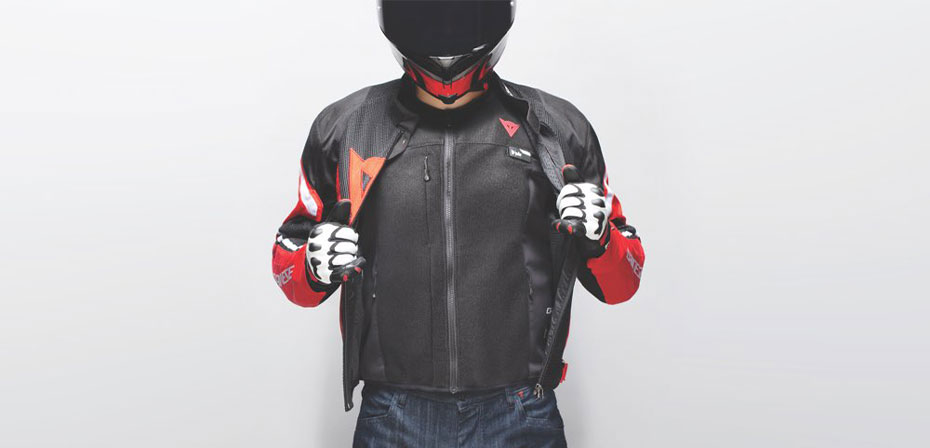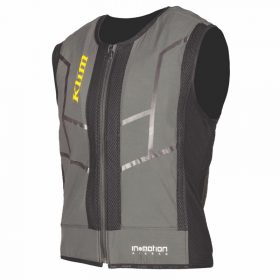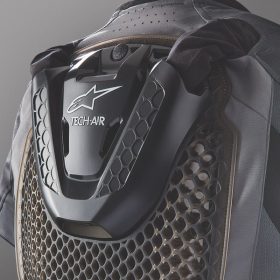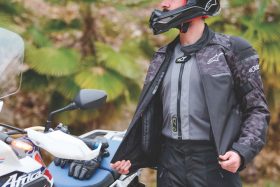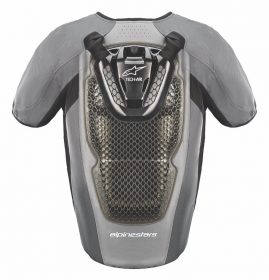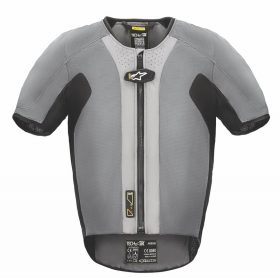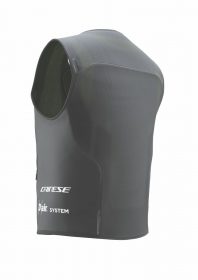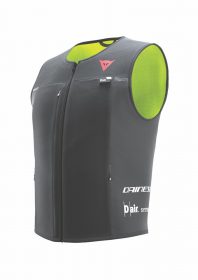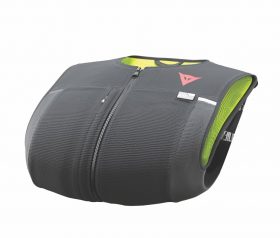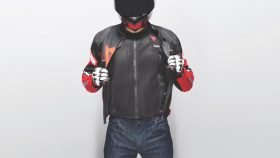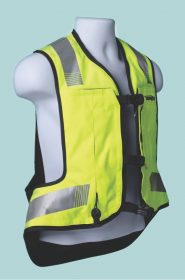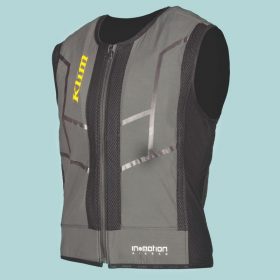Airbag jackets and vests are the latest in motorcycle safety technology.
There can be no argument that airbag garments are the biggest safety boon to motorcyclists since helmets. Oh, I suppose that there will be a few – like those still contending the earth is flat – will take issue with such a sweeping statement. But the science – the impact softened, the rapidity of reaction and the number of injuries reduced in top-flight racing – is inarguable. Having an inflatable supplemental safety device built into your jacket significantly reduces the probability of injury. I’m not going to argue airbags’ relatively safety merits; if you really do think airbags are a waste of time, please don’t read any further.
Indeed, that’s the last I’m going to mention of their efficacy. The rest of this discussion will deal with why they are so effective and, despite their acknowledged propensity to reduced injury, why they are still rare as hen’s teeth. That’s especially true of the most modern – that should be read as “expensive” – Alpinestars and Dainese wireless systems. Sales of non-racing air-bag garments, to put it bluntly, have been far below expectations.
Most of that resistance among motorcyclists has been attributed to cost. And, with the original jackets – Dainese’s D-Air Cyclone or Alpinestars’ Tech-Air Revenant, for example – retailing for over two grand when they went on sale, arguing the point about improved safety is difficult. However, having now tested almost a dozen such garments – everything from a tether cord-actuated Helite Vented to the latest Dainese Smart Jacket – I contend the bigger roadblock to mass adoption has been comfort. Airbag-equipped jackets have been heavy, bulky and, especially for someone born and raised in northern Quebec, hot as Hades to wear in the summer. Even if you could afford one, they were often too uncomfortable to wear.
However, after nearly four years of testing almost a dozen airbag-equipped jackets, I have found solutions alleviating many, if not quite all of the issues I had with the first generation of airbag garments. So much so that, this past summer, I did not ride anywhere – not even popping down to my local grocery store – without donning an airbag-equipped jacket. This is what I’ve learned:
The Problem With Airbag Clothing
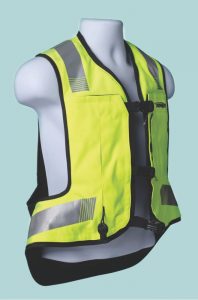 It’s hardly a surprise that an airbag- equipped jacket is bulky. After all, you’re adding an explosive cartridge and an airbag (not to mention a computer and a battery in the wireless versions). The good news is that once you’re wearing such clothing, that extra weight is hardly noticeable. Oh, the airbag adds bulk – enough that you’re probably going to need a jacket that is sized larger than normal to accommodate the tighter fit – but you quickly get used to it.
It’s hardly a surprise that an airbag- equipped jacket is bulky. After all, you’re adding an explosive cartridge and an airbag (not to mention a computer and a battery in the wireless versions). The good news is that once you’re wearing such clothing, that extra weight is hardly noticeable. Oh, the airbag adds bulk – enough that you’re probably going to need a jacket that is sized larger than normal to accommodate the tighter fit – but you quickly get used to it.
The bigger problem is that the airbag itself is totally windproof and, in the dog days of summer, said lack of ventilation can become unbearable, as the lack of cooling turns many airbag-equipped jackets into mobile saunas. Pretty much every review I’ve read from supposedly independent journalists, sloughs off this complaint as a mere inconvenience. Bull patooties. Imagine riding around in a heat wave with your jacket’s winter thermal layer installed – that’s what it’s like to be wearing some airbag-equipped jackets.
In this regard, Dainese D-Air jackets are a little worse than Alpinestars Tech-Air, mainly because insisting that the airbag be in precisely the right spot for protection, means Dainese’s inner vests grip your body very tightly. Imagine that aforementioned winter thermal layer wrapped skin-tight around your torso. I rode through Italy during a heat wave in my first summer wearing the D-Air Cyclone and the heat was almost unendurable. I was tempted to throw myself down on the road just to have an excuse to take the damned jacket off. And lest you think I’m picking on Dainese here, Alpinestars’ equivalent, the Tech-Air Revenant, isn’t much better.
For the record, both are incredible jackets. The Revenant is the most robust piece of textile street gear I’ve ever tested and the Cyclone is yet another example of why Dainese has a reputation for the finest quality in the motorcycle garment business. But, making reference to my previous maxim, if the thermometer climbs much higher than 30 C, chances are that either choice will be hanging in your closet rather than protecting you from road rash.
A Partial Solution
The major differences between Alpinestars’ Tech-Air system and Dainese’s D-Air is that Dainese builds its airbag right into its jackets and Alpinestars’ Tech-Air vest is sold separately. In other words, you can switch the Tech-Air between jackets, but if you have a Dainese airbag, you are limited to the jacket you bought.
Here in Canada, that’s not as huge advantage for the Tech-Air as it could be, mainly because most of those jackets imported into the Great White Frozen North have been various versions of the company’s three-quarter-length textile adventure jackets – the Revenant as well as the Yaguara – or leather sport versions that all suffer from various degrees of the heat saturation I’ve been talking about.
But, for reasons I have been never been able to fathom, Alpinestars sells – or, more accurately, used to sell – a ventilated Tech-Air-compatible mesh jacket called the Viper in the U.S. It was never imported into Canada, but I bought one in New York – and what a godsend it’s been. Oh, the windproof airbag still means that despite the Viper’s extensively ventilated mesh, it still doesn’t allow as much cooling air to flow through as, say, the most free-flowing of traditional ventilated jackets, Olympia’s AirGlide, does. But what became unbearable at 30 C – which was far too common this past summer – is now tolerable up to 35 C. Indeed, adding better elbow armour –replacing the standard SAS-Tech pads with Alpinestars’ Level II Bio Armour – the Tech-Air-equipped Viper became my go-to jacket for pretty much all of 2019.
However, the Viper seems to have been discontinued. As I was writing this, there does seem to be some remaining stock in the U.S. so, if you already have a Tech-Air vest and suffer from airbag-induced heat prostration, I’d grab one as soon as you can. The Viper’s replacement is the Tailwind, which is Tech-Air-compatible and sold in Canada. (Fortnine lists two colours at $549.95). I have not tested the Tailwind, but it appears to have a sturdier chassis than the Viper does. And if it’s like the rest of the Alpinestars jackets I’ve tested, the CE Level I elbow and shoulder armour can be replaced by Alpinestars’ Level II Bio Armour.
Whatever airbag jacket you’re shopping for, two points need to be emphasized. The first is that any airbag needs to be mated with a jacket with ventilation. The second conclusion is that if you are shopping specifically for a combined jacket/airbag vest, Alpinestar’s modular system is superior to Dainese’s single-unit alternative.
Dainese’s Counterpunch
At least in part because of the sky-high prices of those original jackets, both Alpinestars and Dainese have begun offering stand-alone airbag vests that can be combined with any jacket. Their lower price – the Dainese Smart Jacket costs $869.95; Alpinestars’ Tech-Air 5 is $899.95 – and the ability to wear them under a variety of jackets has greatly increased the popularity of airbags.
Now, having some experience with these standalone vests, I’d say that unlike my jacket recommendation, Dainese has the more versatile product. The Tech-Air vest offers a bit more protection – its inflatable bag covers the shoulder well, while the Dainese is not as generous in this area – and it has a built-in CE Level I back protector. However, the Smart Jacket is more conducive to air flow and, indeed, tucked beneath said vented Olympia, passes a little more cooling air than the aforementioned Viper Tech-Air – although, obviously, not as much as the vest-less AirGlide does.
And I think not having a built-in back protector is actually a benefit. Yes, having a CE1 unit built into the Tech-Air 5 lets Alpinestars claim its vest protects 18 times better than a traditional back protector, while the armourless Smart Jacket is “just” equivalent to seven back protectors. Except, of course, the Dainese is designed so that you retain a CE1 – or, better yet, a CE Level 2 – protector in the jacket while the Alpinestars version does not. Suffice it to say that both will offer stupendous protection when used as recommended.
But not having a back protector built into an airbag garment itself means Dainese’s Smart Jacket can be folded for storage and easily fit in your top case when not in use or in your luggage if you’re off on a far-flung motorcycle adventure. More important, if you do take off that garment because it becomes too hot, you’re at least left with whatever standard armour your jacket came with (and, again, you chose something with a CE 2 rating. Right?). Since whatever you’re wearing over the Alpinestars vest has had its back protector removed, if you doff the vest, your spine is now vulnerable – pretty much obviating the reason you bought the airbag in the first place.
For all these reasons, Dainese’s Smart Jacket makes more sense to me than the Tech-Air 5 does.
One Last Twist
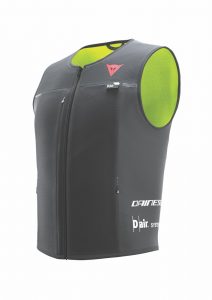 If the decision between Alpinestars versus Dainese is relatively easy – the former for complete jackets; the latter for the stand-alone vest – choosing between the two solutions I have suggested proved much more difficult. I really enjoy my Alpinestars Tech-Air Viper, while the Dainese Smart Jacket is useful under pretty much any jacket you may already own.
If the decision between Alpinestars versus Dainese is relatively easy – the former for complete jackets; the latter for the stand-alone vest – choosing between the two solutions I have suggested proved much more difficult. I really enjoy my Alpinestars Tech-Air Viper, while the Dainese Smart Jacket is useful under pretty much any jacket you may already own.
At first blush, the fact that the Alpinestars alternative requires two jackets – the Viper/Tailwind for the summer months and the Revenant when the weather gets chilly – seems inordinately expensive. By the time you bought both jackets and the airbag vest, you’re looking at darn near three grand.
But… I tried the Viper with my Venture Heat heated vest and, presto, instant four-seasons comfort. Indeed, the Viper combined with the electric vest was so comfortable all the way down to 5 C that there was no real need for the heavier windproof Revenant. If you already have an Alpinestars Tech-Air Street vest, my recommendation is that you get a Viper or a Tailwind-compatible jacket and marry it with whatever heated liner tickles your fancy. Of all the single-jacket alternatives, I found this combination was by far the most versatile and comfortable.
The Hot Air Stops Here
So, were I contemplating buying an airbag-equipped garment all over again, would I buy the Viper/Tailwind/Tech-Air/Venture Heat combination or buy a Dainese Smart Jacket and match it to my jacket of choice?
While I would be very tempted to go with the Viper and electric vest combination, my default choice during this past summer was to pair the Dainese Smart Jacket with that company’s D-Explorer, a three-quarter-length adventure jacket with copious amounts of venting. That combination is lighter and more comfortable than the alternatives, not to mention more versatile (again, the result of the airbag vest being foldable and the fact that it can be removed while retaining the jacket’s original back protector). For year-round comfort, I’d still take along the electric vest (which fits even better in the Dainese combination than it does in the Alpinestars jacket). You never know when it might get chilly.
Whatever your choice, the bottom line is that airbag jackets used to be expensive and impractical. They are neither anymore. They are simply the best protection you can buy. If you value your safety, there isn’t any excuse not to wear the latest in motorcycle safety gear anymore.
A Couple of Other Products
KLIM
Those who have shopped for airbag gear will have noticed that I have not included any information about either the various “tethered” systems out there or Klim’s recent foray into wireless airbag vests. As for the latter, Klim’s system was built in conjunction with France’s In&motion and the combination most closely resembles the Alpinestars Tech-Air 5 since the former has a built-in back protector. The Klim vest costs less than the Dainese or Alpinestars alternatives, but you have to pay a monthly subscription to keep its electronics activated.
HELITE
As for tether cord-equipped vests, I’ve owned a Helite Vented jacket for about three years. It’s an excellent product, its main disadvantage being that it is slower to react. The wireless systems take 20 to 60 milliseconds to actuate, tethered versions take 80 to 100 milliseconds. While that’s plenty fast enough to protect you in a highside or other single vehicle get-off, it’s difficult to determine if its activation would be quick enough to protect you should you slam into the side of a car. And, notably, refitting the Helite and Klim/In&motion systems with new inflators costs significantly less than other airbag-equipped garments and the former can be recharged by the owner. Also, a Helite Vented jacket, complete with mechanical airbag, is about the price of a stand-alone Dainese or Alpinestars vest.
Recharging After Inflation
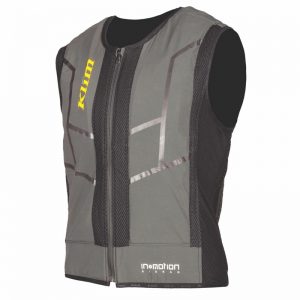 It is worth noting that refitting new inflators to the Helite and Klim/In&motion systems is simpler and costs significantly less than for competing Alpinestars and Dainese systems. A replacement Helite CO2 cartridge costs between $45 and $60 while a Klim replacement canister is $129.95. Both can be replaced by the owner. Klim recommends a maximum of three inflations to its airbag, and as mentioned earlier, the system requires a monthly subscription.
It is worth noting that refitting new inflators to the Helite and Klim/In&motion systems is simpler and costs significantly less than for competing Alpinestars and Dainese systems. A replacement Helite CO2 cartridge costs between $45 and $60 while a Klim replacement canister is $129.95. Both can be replaced by the owner. Klim recommends a maximum of three inflations to its airbag, and as mentioned earlier, the system requires a monthly subscription.
Alpinestars and Dainese systems, meanwhile, must be repacked by a professional. The former requires deployed air bags be sent back to their American headquarters for repacking at a cost of US$300 (plus shipping) while Dainese wants you to take it back to an authorized dealer like our friends at Riders Choice who charge between $315 and $350 depending on the exact model (standalone Smart Jackets are obviously at the low end of that scale).









